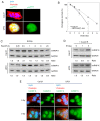Heterogeneous nuclear ribonucleoprotein K is overexpressed and contributes to radioresistance irrespective of HPV status in head and neck squamous cell carcinoma
- PMID: 32901844
- PMCID: PMC7521550
- DOI: 10.3892/ijmm.2020.4718
Heterogeneous nuclear ribonucleoprotein K is overexpressed and contributes to radioresistance irrespective of HPV status in head and neck squamous cell carcinoma
Abstract
Radiotherapy is a major treatment option for head and neck squamous cell carcinoma (HNSCC). However, the success of radiotherapy is limited by tumor cell resistance to ionizing radiation (IR). Clinical studies have demonstrated an overall improved prognosis and higher susceptibility to radiotherapy of high‑risk human papillomavirus (HPV)‑associated HNSCC compared with classic HNSCC, as well as worse overall survival for male HNSCC patients. Overexpression of heterogeneous nuclear ribonucleoprotein (hnRNP) K has been associated with resistance to radiotherapy in melanoma and colorectal carcinoma. The aim of the present study was to analyze the impact of hnRNP K expression on the aggressiveness and radioresistance of HNSCC with respect to patient sex and HPV status. Immunohistochemical staining of HNSCC tissue specimens revealed elevated hnRNP K levels compared with those in the non‑neoplastic epithelium. Cytoplasmic hnRNP K accumulation was associated with advanced tumor stage and male sex. Exposure of HNSCC cells to IR was followed by rapid upregulation of hnRNP K at the protein level, along with re‑localization from the tumor cell nucleus to the cytoplasm. siRNA‑based knockdown of hnRNP K induced apoptosis and abolished tumor formation after xenotransplantation of HNSCC cells onto the chick egg chorioallantoic membrane (CAM). The observed effects were independent of the respective HPV status of the cell lines. These results indicated a tumorigenic and anti‑apoptotic role of hnRNP K in HNSCC, which appeared to be enhanced in male patients and contributed to the radioresistance of these tumors. However, the radioprotective effects of hnRNP K were found to be independent of the tumor's HPV status.
Figures




Similar articles
-
Baseline MAPK signaling activity confers intrinsic radioresistance to KRAS-mutant colorectal carcinoma cells by rapid upregulation of heterogeneous nuclear ribonucleoprotein K (hnRNP K).Cancer Lett. 2017 Jan 28;385:160-167. doi: 10.1016/j.canlet.2016.10.027. Epub 2016 Oct 25. Cancer Lett. 2017. PMID: 27793696
-
Association of lnc-IL17RA-11 with increased radiation sensitivity and improved prognosis of HPV-positive HNSCC.J Cell Biochem. 2019 Oct;120(10):17438-17448. doi: 10.1002/jcb.29008. Epub 2019 May 22. J Cell Biochem. 2019. PMID: 31119798
-
Radiosensitization and downregulation of heterogeneous nuclear ribonucleoprotein K (hnRNP K) upon inhibition of mitogen/extracellular signal-regulated kinase (MEK) in malignant melanoma cells.Oncotarget. 2015 Jul 10;6(19):17178-91. doi: 10.18632/oncotarget.3935. Oncotarget. 2015. PMID: 26136337 Free PMC article.
-
Biomarkers of radioresistance in head and neck squamous cell carcinomas.Int J Radiat Biol. 2023;99(4):583-593. doi: 10.1080/09553002.2022.2110301. Epub 2022 Aug 15. Int J Radiat Biol. 2023. PMID: 35930497 Review.
-
Molecular mechanisms underlying increased radiosensitivity in human papillomavirus-associated oropharyngeal squamous cell carcinoma.Int J Biol Sci. 2020 Feb 4;16(6):1035-1043. doi: 10.7150/ijbs.40880. eCollection 2020. Int J Biol Sci. 2020. PMID: 32140071 Free PMC article. Review.
Cited by
-
Exploring the landscape of current in vitro and in vivo models and their relevance for targeted radionuclide theranostics.Eur J Nucl Med Mol Imaging. 2025 Jul;52(9):3291-3311. doi: 10.1007/s00259-025-07123-3. Epub 2025 Feb 28. Eur J Nucl Med Mol Imaging. 2025. PMID: 40016527 Free PMC article. Review.
References
-
- Franceschi S, Talamini R, Barra S, Baron AE, Negri E, Bidoli E, Serraino D, La Vecchia C. Smoking and drinking in relation to cancers of the oral cavity, pharynx, larynx, and esophagus in northern Italy. Cancer Res. 1990;50:6502–6507. - PubMed
MeSH terms
Substances
LinkOut - more resources
Full Text Sources
Medical
Miscellaneous

